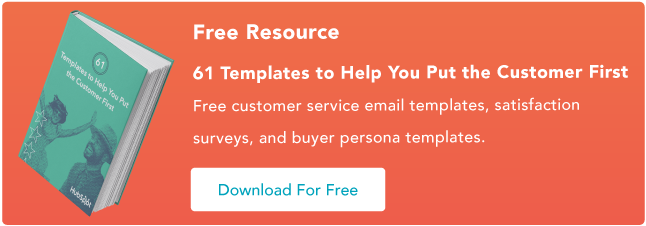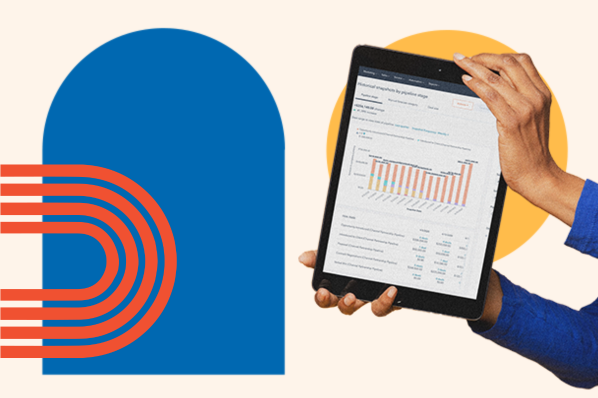Creating a successful cross-channel marketing campaign requires great effort. In an ideal world, we would always know how and when to reach our customers. We could have a single channel for interacting with them, converting them, and continuing to delight them. All of our marketing, sales, and service efforts could be easily tracked and enhanced as we created the ideal customer experience within this single channel.

Unfortunately, ideal situations seldom apply to businesses. As anyone who has ever tried to meet a quota of leads or customers can attest, if you only market in a single channel, you're going to miss out on a large portion of your target audience. In fact, focusing on a single channel can even make for a poor customer experience and prevent you from successfully nurturing your leads.
Making a positive impression on your audience requires meeting them where they're at, giving them the attention and content that they need when they need it and how they want it. That's where cross-channel marketing comes in. It gives you a powerful, interconnected approach be where your customers are. But, being successful at cross-channel marketing requires more than just publishing content across your various marketing channels. To do it well requires seamlessly bringing your content together and creating a unified experience.
Below, we'll explain just how to go about doing that.
Skip to:
- Cross-Channel Marketing Definition
- Difference Between Cross-Channel and Omni-Channel Marketing
- Cross-Channel Marketing Benefits
What is cross-channel marketing?
Cross-channel marketing is a method brands use to connect with customers across multiple channels (i.e. email, social media, ads, SMS) that creates a logical progression for your target audience to progress from one stage to the next. These channels work together and provide context for the messages your persona receives as they go from one channel to the next.
To sum this up succinctly, cross-channel marketing enables marketers to reach customers through multiple channels, with each serving experiences relevant to where they are along the customer journey. This provides customers with consistent and cohesive messaging across the board.
The Difference Between Cross-Channel & Omnichannel Marketing
It's important not to confuse cross-channel marketing with omnichannel marketing. Omnichannel marketing (sometimes called multi-channel), like cross-channel marketing, utilizes several marketing channels to interact with customers, but these marketing efforts typically lack unity.
In omnichannel marketing, you may send your customers an email about an upcoming deal, run some targeted ads on social media to improve your brand recognition, and publish blog posts about the topics most relevant to your business. Each of these is an effective method for nurturing leads, but in multi-channel marketing, they're treated as independent entities. Your emails have their own goals and topics, as do your social media ads and your blog posts. As a result, your marketing efforts essentially operate independently, making it difficult to tie any particular effort back to ROI.
With cross-channel marketing, you're bringing each of these venues into unison with each other so that they build off of each other and amplify their impact. For example, if a lead reads a blog post you wrote about the pitfalls of an issue that your business solves, the marketing email they later receive might provide a customer testimonial from someone who overcame that same issue using your product. Then, when the lead gets on social media later that evening, they'll see an advertisement with a catchy headline about how your products or services completely remove the issue they were initially reading about.
Cross-Channel Marketing Benefits
Rather than presenting potential customers with fragmented messages about all the great things you can do, the products you offer, or the deals that you're running, they're getting the content that is most relevant to their needs across a variety of channels. This gives you a clear brand impression for that lead, and it makes their experience with you as seamless and direct as possible. Additionally, because there's clear interconnectedness between each portion of the marketing experience, it's easier to view your marketing efforts in a cumulative way, which can help you to calculate and understand marketing ROI more clearly.
Why Use Cross-Channel Marketing?
Regardless of the industry that you're in, the key to an effective marketing strategy is to understand your target persona. You can't market effectively if you don't have a thorough understanding of who it is that you're marketing to. Otherwise, you're just scattering marketing efforts into the wind and hoping that something lands correctly.
In the digital age, when consumers are constantly being bombarded and interrupted by brands that are competing for their attention, understanding your target persona requires understanding how they interact with brands and make buying decisions. It requires being in touch with where they're getting the information to make these decisions (i.e. what channels they're on), as well as how they want to receive this information (i.e. what distinguishes you from the ads that they actively ignore).
Cross-channel marketing works to solve this issue by meeting your customers where they're at and in a format that's not likely to be overlooked. By doing so, you're going to be:
- Increasing engagement with your content by personalizing each touch point to cater to your individual leads
- Improving customer loyalty
- Making it easier to contextualize individual channel metrics within overall ROI
Let’s take a closer look at the benefits of deploying cross-channel marketing strategy.
1. Increased Engagement
With the sheer volume of ads that consumers see in a day, many have gone "ad-blind," and scroll past your PPC ads, boosted posts, and marketing emails without giving them a thought. Think about your own experiences as a consumer. Many of us open our email in the morning and bulk delete the generic marketing emails that clutter our inboxes without even reading the entire subject line.
If I've been working on figuring out a complex issue for my team, however, and have already come across a brand that I view as an authority on that issue, receiving a marketing email or seeing an ad about that topic is going to be more likely to catch my attention and not get deleted in my daily inbox cleaning efforts.
Consumers respond positively to personalized content. For example, calls to action that contain personalized content perform 202% better than generic CTAs.
2. Greater Customer Loyalty
This leads to an improved brand experience as a consumer, which increases a buyer's sense of delight. As any marketer knows, a delighted customer is a loyal customer, and combining loyalty with delight is the recipe for creating your most powerful marketing tool: a brand ambassador.
Consumers generally want to have a reason to keep coming back. It's easier to know that you have a go-to resource for a given type of issue or need than to have to go through the process of researching, comparing, and testing solutions. For many buyers, it's simply more convenient to upgrade or purchase additional services from a provider they already know and trust, even if it's slightly more costly, than to find someone brand new who can do the same thing. When a customer trusts you and you genuinely want to help them succeed — and your unified marketing and customer service efforts demonstrate that– you remain front of mind as an authority.
3. Proven ROI
Combining your efforts with a cross-channel marketing approach will help to break down silos that decontextualize metrics and don't always accurately represent the success of your marketing campaigns. For example, if you look at your marketing efforts from a single-channel or multi-channel approach, your email marketing team may be focused on getting opens or CTA impressions. Meanwhile, your social media team is focused on getting impressions or likes. Finally, your content team is looking at blog views.
When a lead is generated or a sale is made, each of these channels wants to take the credit for it and will look at their own metrics as proof of their influence in getting that win. By integrating these efforts across channels, you're able to clearly map out the various touch points to see how a viewer became a lead, and how a lead became a customer and contextualize the work that each channel is doing. Not only does this create a clearer roadmap for refining your marketing efforts, but it also helps to avoid falling into the traps of vanity metrics.
How to Get Started with Cross-Channel Marketing
When getting started with cross-channel marketing, it's important to keep in mind that you'll likely need to tweak your approach and make ongoing optimizations as you get better at cross-channel marketing. The more data you collect, the better you'll understand your customers' cross-channel buying experience, which will give you insights into improvements you can make across each channel.
Here’s how to launch a cross-channel marketing campaign of your own:
1. Unify your data.
If you haven't already clearly defined your customer persona, do so before diving into cross-channel marketing. Having a clear concept of your buyer's persona is the starting point for any marketing effort.
Assuming you've already developed your persona, the first step and backbone of any successful cross-channel strategy is having unified data within a customer data platform (CDP). Oftentimes, your business' customer relationship management (CRM) platform will be able to manage this data, so you can likely get started by building off of the tools that you already have. Regardless of the specific CDP that you go with, you'll want to make sure that you have the analytics data available to capture each of your leads' touchpoints.
Typically, this will involve using tracking URLs or browser cookies to associate online actions with an individual lead's contact profile. You'll want to be able to see which emails they've been sent and have interacted with, which social media campaigns have made an impression on them, the blog posts that they've read, PPC campaigns they've clicked on, and conversations that your sales or service team have had with that customer. Whatever channels you have used for marketing– or that you will use– need to be reflected within your CDP.
To learn more, read everything you need to know about data management platforms.
2. Clarify your customer segments.
Ideally, your CDP will be able to create meaningful reports across customers that help you to visualize and understand this data. But, even if you have to do some number-crunching by hand, your second step to getting started with cross-channel marketing is to understand the varying segments within your customer persona.
Look across the data related to your touch points to see if there are any clear successes, failures, or trends that you can identify. For example, you'll likely notice that most of your leads who have already converted into customers have something in common, whether that's a minimum number of interactions before converting, average time spent interacting with your marketing efforts before converting, or even specific campaigns with high conversion rates.
By analyzing your customer data and creating a clear mental picture of the segments within your contact database you'll be able to determine which channels to prioritize and the type of content that performs best for your business across each channel.
Moving forward, it's also important to document and contextualize each interaction so that you can successfully cater your content to your customers.
3. Use smart content to unify your interactions.
If your CDP is integrated with your content management system (CMS), this step will likely be a bit easier than if they're operating independently of each other. Even if they aren't integrated, you can still be successful with cross-channel marketing; it may just require more hands-on work to personalize your content.
With your customers analyzed and segmented based on their interactions, your next step is to begin the process of customizing your content so that it matches each viewer's needs.
The most direct way of accomplishing this is to utilize smart content. Smart content is dynamic content that is determined by a certain set of criteria. To put it simply, smart content says "if a viewer has done this, show them that." This is why it's necessary to have all of your customer interaction data unified within your CDP. You'll be able to clearly identify who has done what, so your subsequent interactions will be built upon established touchpoints.
Plus, with 83% of marketers stating it’s more effective to create higher quality content less often, you can focus on quality over quantity.
It's also important to be tapped into the type and format your customers consume most. For the third year in a row, our Marketing Trends Report found that videos are the most popular with 59% of marketers making it their go-to format.
 If your CMS is able to utilize smart content, create content — or at least sections of content — based upon the segmented lists you've broken your contacts into. For example, let's say you're publishing a blog post about one of your core services. You can customize this blog post for various segments so that customers who you've deemed to be the warmest leads based on past interactions will see a CTA to contact sales to get started. If you know that another customer has already viewed your pricing page, perhaps this CTA will show an offer for them to claim 10% off. For contacts who haven't had many interactions, or for whom this is their first interaction, this section may be replaced with recommended content about the same topic.
If your CMS is able to utilize smart content, create content — or at least sections of content — based upon the segmented lists you've broken your contacts into. For example, let's say you're publishing a blog post about one of your core services. You can customize this blog post for various segments so that customers who you've deemed to be the warmest leads based on past interactions will see a CTA to contact sales to get started. If you know that another customer has already viewed your pricing page, perhaps this CTA will show an offer for them to claim 10% off. For contacts who haven't had many interactions, or for whom this is their first interaction, this section may be replaced with recommended content about the same topic.
Regardless of where these readers are at in the buyer's journey, you're showing them the content that's most relevant to where they're at. If your CMS isn't integrated with your CDP or CRM, you'll want to leverage other means of communication to manually cater your content to your viewers' individual needs. For example, if you've been able to identify three distinct variations of one of your personas, put that information to good use and create three variations of your next newsletter so that each segment gets the most relevant content. Additionally, you can use this knowledge to create custom audiences for targeted advertising on social media.
4. Optimize and repeat.
One of the biggest advantages of cross-channel marketing is that you can report on and analyze the ways in which your marketing strategies in one channel affect another. Simply having this data is enough to give you valuable insights into your ROI. But, if you want your cross-channel marketing to be even more productive, you can also analyze this information to look for ways to make ongoing optimizations to your cross-channel marketing approach.
Use this data to your advantage and run experiments– such as A/B testing in your emails, adjusting the traits of your target audience for Facebook ads, or the placement of your calls-to-action to continue unearthing new and valuable insights into your customers. As you prepare to implement additional cross-channel marketing campaigns, you'll be able to enrich each step with the data you've already gathered.
How Will You Grow with Cross-Channel Marketing?
By leveraging cross-channel marketing, not only will your team be able to execute powerful marketing strategies, but by unifying your data within a customer data platform, you'll also have more meaningful insights into your customer's behavior. That knowledge means that you'll have greater opportunities to cater your sales, marketing, and customer service interactions to each and every one of your contacts. When you can access that information, you're on track to delight your customers at every turn. From there, you can grow wherever you want to.
Editor's note: This article was originally published in December 2018 and has been updated for comprehensiveness.
![→ Free Download: 61 Templates to Help You Put the Customer First [Download Now]](https://no-cache.hubspot.com/cta/default/53/a66c79d4-2a39-46e6-a80a-f7b999133c06.png)


![Customer Profiling in 10 Easy Steps [+ Templates]](https://blog.hubspot.com/hubfs/customer-profiling_2.webp)





![What Is an Identity Graph? [The Plain-English Guide]](https://blog.hubspot.com/hubfs/identity-graphs.jpg)

